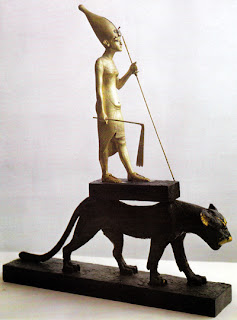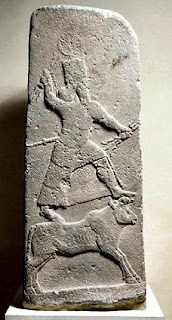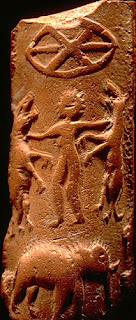

Pictures: Tutankhamen,Egypt & Adad on bull
(Tamil version of this article is also available: london swaminathan)
Vahanas are Mounts of Hindu gods and goddesses. For thousands of years Hindus have been worshipping their gods mounted on vahanas. Mostly they are animals. Big Temples in Tamil Nadu take their beautifully decorated gods and goddesses on various vahanas along the streets of the town. It is happening even today. During the annual festival of each temple, gods’ processions are organised. Some temples like Madurai Meenakshi temple do it more times in a year.
The origin of Vahanas is shrouded in mystery. Hindu Agamas have rules about Vahanas for each deity, each day and specific decoration. Various philosophical explanations are given about the vahanas. But before going into the details, let us look at the mounts of gods and goddesses around the world. This shows the influence of Hinduism, what is known as Sanatan Dharma, is around the world.
Chronologically speaking Vahanas first appeared in the Middle East in Babylonian and Sumerian cultures. We see them in Egypt and Greece. In India, it has started in Indus Valley. I have already written about Indra on his elephant Airavata in an Indus seal. Some scholars interpreted the figure as a woman standing on elephant. We have Indra’s wife Indrani on elephant in a Bangladesh sculpture. Either way it can be interpreted as Vedic Gods.
Most of the ancient Vahanas are in standing position. But later day Hindu iconography showed them comfortably sitting on an animal or a bird. Kanchi Shankaracharya (who attained Samadhi when he was 100 year old) gave a series of lectures in Chennai in 1935. Talking about California may be a corrupted word for Kapila+Aranaya=kapilaranya (read my article about Is California ,kapilaranaya?) etc., he raised a question and answered at one go “did Hindus go around the world to spread their religion? No. This was the religion that existed once in all parts of the world”.
I agree fully with Sri Kanchi Paramacharya. We see the vestiges of Sanatan Dharma in all parts of the world and Sanskrit words and names of Vedic Gods in every culture. Going by this rule, we can boldly say that the Hindu Vahanas seen in Egypt and Sumerian sculptures are due to Hindu influence.
Now look at the deities on animals in other parts of the world:
HINDU RELIGION IS THE ONLY RELIGION WHERE GOD IS WORSHIPPED IN FEMININE FORM FROM VEDIC DAYS TILL TODAY.
Lot of deities like Ishtar, Astarte, Inana, Lilith, Kadesh, Qudhu and Hathor are shown riding a lion like the Hindu goddess Durga.
Ishtar was worshipped from 2500 BC till 200 AD in the Middle East. She was compared with Inana of Sumerian culture. Inana ‘s worship goes back to 3500 BC She was the oldest god shown on a lion. She was the goddess of fertility and war. Even today Hindus worship Durga on lion as Goddess of War.


Pictures: Indra on elephant from Indus valley and Astarte on lion from Middle East
Inana was the paramount goddess of Sumerian pantheon. She was one of three deities involved in primordial battle between god and evil. Ishtar is the counterpart of Sumerian Inana.
Lilith was the first wife of Adam in Hebrew mythology. Lilith may have been derived from the Mesopotamian fertility goddess Nin lil. She is shown standing on two lions.
Qudshu (Kadesh) was the goddess of good health. She was the consort of fertility god Min of Egypt. She was of Syrian origin but thought of as another form of Egyptian Hathor. She was depicted naked standing on a lion. She holds snake and lotus flower in her hands.
Astarte , the goddess of the evening star, of war and sexual love, was shown with lion like sphinx on either side. We see some similarity in these descriptions. They were the symbols of fertility or war. Hindu Vedas portray goddesses in the same way and till this day they are worshipped in Sri Suktam, Durga Suktam etc.
Tutankhamen on Tiger
Tutankhamen (1333 BC), the most famous boy king of Egypt was shown standing on a tiger. This is clearly due to Hindu influence. His great grandparents married two Hindu girls from Syria. Mittanni king Dasaratha (Tushratta) who ruled Syria Turkey regions gave his daughters in marriage to an Egyptian king. We have the evidence of Vedic Gods for the first time in Bogazkoy inscriptions (please read my posts on oldest Sanskrit inscriptions). Seti, another king who ruled after Tutankhamen, was also shown on a tiger. Kings were considered god in Egypt.
Padmasambhava, an Indian mystic who went to Tibet and Mongolia to spread Buddhism was shown riding a tiger like the Hindu god Ayyappa of Kerala and Hindu goddess Durga.
Bull Riders
Bull (Nandhi) was the vahana of Hindu god Shiva. Indra was compared to bull in hundreds of places in the Hindu Vedas. A god known as Adad, holding Indra’s thunderbolt, was shown riding a bull in Akkadian sculptures.
Adad had its origin in Mesopotamian around 1900 BC. He was worshipped as a weather god, similar to Indra of Rig Veda. His sculptures were found in Karkara, Mari, and Aleppo in Syria. His other names were Ramman and Iskur.
Iskur was worshipped in Iraq from 3500 BC in Iraq.
Baba Iaga , a witch or ogress of Slav regions was shown riding a pig.
Hindu epics and Puranas give a vivid description of various vahanas. We have excavated coins with Kartikeya on peacock from second century BC. A lot of beautiful sculptures show Hindu vahanas in Cambodia, Indonesia and the Indian subcontinent. (contd. In second part)
Contact [email protected]
